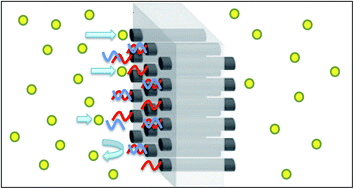Reversible gating of ion transport through DNA-functionalized carbon nanotube membranes†
Abstract
Carbon nanotubes (CNTs) can be used to create unique fluidic systems for studying ion transport in nanochannels due to their well-defined geometry, atomically smooth and chemically inert surface, and similarity to transmembrane protein pores. Here, we report the reversible molecular gating of ion transport across DNA-functionalized CNT membranes. The diffusive transport rates of ferricyanide ions through membranes, each with an array of aligned transmembrane CNT channels, were monitored. Single-stranded DNA (T15) gate molecules were covalently linked to CNT channel entrances, and reversible opening and closing of CNT channels were achieved by the addition and removal of complementary DNAs (A15) with a remarkable open/close flux ratio of >1000, which is substantially higher than the protein-gated CNT systems reported previously. Furthermore, at least two-orders of magnitude difference in ion fluxes was observed when single base-pair mismatched DNAs were used in place of the complementary DNAs. Comprehensive theoretical analysis is also presented. The experimental results can be explained by steric hindrance, ion partitioning, and electrostatic repulsion at the CNT entrances, as well as the thermodynamics of DNA binding.



 Please wait while we load your content...
Please wait while we load your content...